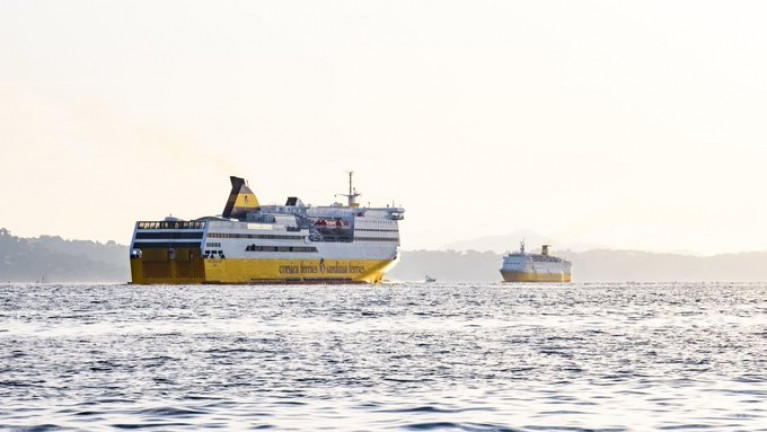Afloat tracked Mega Express Four, which normally serves in the Mediterranean Sea is currently on charter to Irish Ferries, however strong gale force winds required towage assistance prior to a debut Ireland-France crossing, writes Jehan Ashmore.
The towage scene last Saturday afternoon involved Purple Water Towing's Giano and a Dublin Port Company tug Beaufort, aptly name after Francis Beaufort who in 1805 developed a method to measuring wind speeds. The officer of the Royal Navy first officially carried out on board HMS Beagle and the wind-scale still remains widely in use today.
While Beaufort assisted Mega Express Four at the bow, Giano was kept busy at the stern and together they aided in turning the former Superfast II. This anti-clockwise swing of the ship off the berth at Dublin Ferryport Terminal No. 1 is from where up to then the Corsica Ferries ship was first deployed to serve Dublin-Holyhead sailings. This was to enable covering for Ulysses sailings while off service for annual overhaul (see below).
Around the same time Mega Express Four was under tug assistance, out in the Dublin Bay the MetOcean/Smart Buoy registered a wave height of 2.8m, wind direction of 175 °(S), gust direction of 176 °(S), average wind of 23 knots and gust reaching 40 knots.
As Mega Express Four further headed into Dublin Bay, the seas observed were increasing with a headsea resulting with spray over the bow becoming frequent. By the time the ferry operating essentially in a freight-only mode, had passed The Muglins Beacon off Dalkey, the spray was higher and almost reached the bridge.
Despite the adverse weather conditions, the Mega Express Four's inaugural Dublin-Cherbourg sailing schedule set for 1600 was only about half an hour late in departing the Irish capital. On the opposite side of the Irish Sea is where the operator's Dublin-Holyhead routine main ferry, Ulysses is undergoing a planned overhaul in a dry-dock at Cammell Laird, Birkenhead on Merseyside.
Also on the Irish Sea route is W.B. Yeats which since January had been operating the Dublin-Cherbourg route having boosted freight capacity given the importance of this Bypass-Brexit route.
The transfer of W.B. Yeats on the Ireland-France service was four months in advance of 'cruiseferry' based sailings not scheduled to begin until May on the year round operated route. Consultation of the operator's website confirms such sailings start in May.
W. B. Yeats is the largest ferry in the company's fleet and also operating from the island of Ireland, however despite transferring on the Ireland-Wales route, ropax Epsilon has returned to the Ireland-France route as the service's second but main ship.
As Mega Express Four concentrates crossings to Cherbourg where the continental mainland route is run but only with a weekend round trip. This was first completed on Monday of this week, with the chartered Genoese-registered ferry returning to Dublin Bay on a considerably calmer sea.
According to Corsisa Ferries the charter of Mega Express Four to (ICG parent company of) Irish Ferries is for two-months. This will see the ferry in northern European waters by operating from Ireland to the UK and also to northern France.
“Following the drop in the number of passengers linked to the health crisis, and the shutdown of several of our ships, Corsica Ferries is seeking to broaden its scope of activities and develop in other areas, international in particular.” said Pierre Mattei, president of Corsica Ferries.
Otherwise the ferry's southern France career since 2006 has been through the ports of Nice and Toulon to the Corsican ports of L’Île-Rousse, Ajaccio and Bastia. The island capital is also headquarters of Corsica Ferries SAS but branded on the ships as Corsica Ferries/Sardinia Ferries.
As alluded in the photo caption, a reference to the former B+I Line which Afloat will have more to report on another historical 'ferry' link with the Irish State owned operator and the Mediterranean company.































































